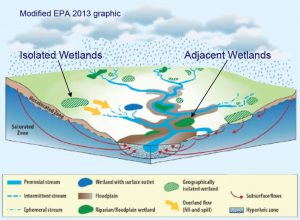
A Brief Summary of EPA’s New WOTUS Rule.
Navigable Waters Protection Rule
The U.S. Environmental Protection Agency (EPA) and the U.S. Army Corps of Engineers (USACE) signed a new Waters of the U.S. (WOTUS) Rule on January 23, 2020. Its unveiling at the National Association of Home Builders’ “International Builders Show” followed an extensive public comment period. The new rule is titled the “Navigable Waters Protection Rule.” It will supersede all previous WOTUS rules and will go into effect 60 days after its publication in the Federal Register.
Basic Background of the Clean Water Act of 1972
The purpose of the Clean Water Act was to allow the federal government to protect water resources (and the interstate commerce that depends on them). It therefore prohibits the discharge of pollution and/or fill into WOTUS without a permit. However, its on-the-ground enforcement has historically been contentious. The definitions of WOTUS have changed over time resulting from lawsuits.
The new WOTUS Rule
At 350 pages, the document detailing the new Rule is quite lengthy. While I have not read the entire document, I have read several summaries and attended a lecture summarizing it. I will do my best to highlight the main differences between it and the last time it was revised. That last revision was the “Clean Water Rule” proclaimed by Obama in 2015 and published in February of 2018.
The purpose of this new Rule is to restore the definition of WOTUS to its pre-2015 definition and to simplify regulation. Implementation of the Clean Water Rule was sometimes subjective due to ill-defined terms such as “Significant Nexus” and “Adjacent.” The new ruling essentially limits what the federal government regulates under the Clean Water Act. For example, it restricts federal jurisdiction of ephemeral streams and some types of wetlands. It was intended to give individual states more control in policing their own wetlands, particularly if they have any unique wetland resources.
However, most states do not have their own wetland permitting process. They instead rely on the federal government to regulate fill and discharge. Delaware is one such state. Although Delaware does regulate tidal waters and Subaqueous Lands, we do not have a freshwater wetland permitting program. One of the biggest criticisms of the new Rule is that it pressures states to regulate their water resources. This could prove expensive, as would the necessary enforcement of any program. For states like Delaware that do not have one, many wetlands will now lack jurisdiction at both the state and federal levels.
Some Changes
More specifically, under this new Rule, the feds will now only regulate wetlands that demonstrate an overland hydrologic connection to permanent or intermittent streams. Thus, the new Rule limits “Adjacency” clauses. (Previous rulings stated that wetlands geographically positioned near streams – whether or not there was an obvious hydrologic connection – were federally regulated along with the stream.) Examples are floodplain wetlands that are often found alongside streams. Some floodplain wetlands may no longer be regulated at the federal level unless they demonstrate an overland connection to the stream during a typical year.
So the new Rule also renders the term “Isolated” to be synonymous with “typically lacking overland connectivity.”
The new Rule also states that the federal government will not regulate “ephemeral streams.” (Ephemeral streams are those that only contain flowing water after rain events or snow melt and are otherwise dry). It also clearly states that the federal government does not regulate “groundwater.” Another change is that it clearly states that the federal government does not regulate man-made impoundments or farm and/or roadside ditches (unless their flow is intermittent or perennial).
What do these changes mean for You?
In response to the new Rule, many organizations and states quickly calculated approximately how many wetlands could now be exempt from federal regulation. The number usually translates to roughly half of all wetlands. For Delaware specifically, it translates to about 15,000 acres of headwaters, isolated wetlands, and floodplain wetlands that may no longer be federally regulated, according to Marla Stelk, executive director of the Association of State Wetland Managers.
Because fewer wetlands and streams will be federally regulated, fewer federal permits will be required for fill and/or discharge activities. And, since compensatory wetland mitigation is oftentimes a permit condition, it can be expected that fewer mitigation projects will be required in the future as well.
If you have any questions as to exactly how this new Rule will affect your project or property, please feel free to contact Landmark’s Sciences Division.
It is important to keep in mind that this new Rule will likely be initially tied up in litigation. Some districts of the USACE may continue to use the old definitions and some may start using the new ones during the interim.
Only time will tell if these changes will result in the state of Delaware developing a freshwater wetland permitting and enforcement program. Shawn Garvin, Secretary of the Delaware Department of Natural Resources and Environmental Control, spoke at the Delaware Wetlands Conference in Wilmington on January 29, 2020. He said “Delaware is one of the states that does not regulate freshwater wetlands and I plan to look into that very soon.”
More Information
The EPA will be conducting a webinar outlining the new Rule on February 13, 2020 beginning at 2 pm EST. Registration is free, but required. You can register for the webinar, and read up on more details of the new Rule, at epa.gov/nwpr.
Contact Amy Nazdrowicz, an environmental scientist and wetland specialist, (AmyN@landmark-se.com) or Craig Smith, a certified professional wetland scientist, (CraigS@landmark-se.com) for assistance or questions about the effect of the new Rule on your project or property.
